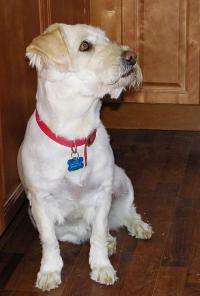Onset of flu season raises concerns about human-to-pet transmission

(Phys.org)—As flu season approaches, people who get sick may not realize they can pass the flu not only to other humans, but possibly to other animals, including pets such as cats, dogs and ferrets.
This concept, called "reverse zoonosis," is still poorly understood but has raised concern among some scientists and veterinarians, who want to raise awareness and prevent further flu transmission to pets. About 80-100 million households in the United States have a cat or dog.
It's well known that new strains of influenza can evolve from animal populations such as pigs and birds and ultimately move into human populations, including the most recent influenza pandemic strain, H1N1. It's less appreciated, experts say, that humans appear to have passed the H1N1 flu to cats and other animals, some of which have died of respiratory illness.
There are only a handful of known cases of this phenomenon and the public health implications of reverse zoonosis of flu remain to be determined. But as a concern for veterinarians, it has raised troubling questions and so far, few answers.
Veterinary researchers at Oregon State University and Iowa State University are working to find more cases of this type of disease transmission and better understand any risks they pose to people and pets.
"We worry a lot about zoonoses, the transmission of diseases from animals to people," said Christiane Loehr, an associate professor in the OSU College of Veterinary Medicine. "But most people don't realize that humans can also pass diseases to animals, and this raises questions and concerns about mutations, new viral forms and evolving diseases that may potentially be zoonotic. And, of course, there is concern about the health of the animals."
The researchers are surveying flu transmission to household cat and dog populations, and suggest that people with influenza-like illness distance themselves from their pets. If a pet experiences respiratory disease or other illness following household exposure to someone with the influenza-like illness, the scientists encourage them to take the pet to a veterinarian for testing and treatment.
The first recorded, probable case of fatal human-to-cat transmission of the pandemic H1N1 flu virus occurred in Oregon in 2009, Loehr said. Details were published in Veterinary Pathology, a professional journal. In that instance, a pet owner became severely ill with the flu and had to be hospitalized. While she was still in the hospital, her cat – an indoor cat with no exposure to other sick people, homes or wildlife – also died of pneumonia caused by an H1N1 infection.
Since then, researchers have identified a total of 13 cats and one dog with pandemic H1N1 infection in 2011 and 2012 that appeared to have come from humans. Pet ferrets have also been shown to be infected, and some died. All of the animals' symptoms were similar to that of humans - they rapidly develop severe respiratory disease, stop eating and some die. Serological studies suggest there is far more exposure to flu virus in cats and dogs than previously known.
"It's reasonable to assume there are many more cases of this than we know about, and we want to learn more," Loehr said. "Any time you have infection of a virus into a new species, it's a concern, a black box of uncertainty. We don't know for sure what the implications might be, but we do think this deserves more attention."
Natural and experimental transmission of the H3N2 influenza virus from dogs to cats in South Korea showed the potential for flu viruses to be transmitted among various animal species, Loehr said. It's unknown if an infected cat or other pet could pass influenza back to humans.
The primary concern in "reverse zoonosis," as in evolving flu viruses in more traditional hosts such as birds and swine, is that in any new movement of a virus from one species to another, the virus might mutate into a more virulent, harmful or easily transmissible form.
"All viruses can mutate, but the influenza virus raises special concern because it can change whole segments of its viral sequence fairly easily," Loehr said. "In terms of hosts and mutations, who's to say that the cat couldn't be the new pig? We'd just like to know more about this."
Veterinarians who encounter possible cases of this phenomenon can obtain more information from Loehr or Jessie Trujillo at Iowa State University. They are doing ongoing research to predict, prevent or curtail emergent events.
Provided by Oregon State University


















